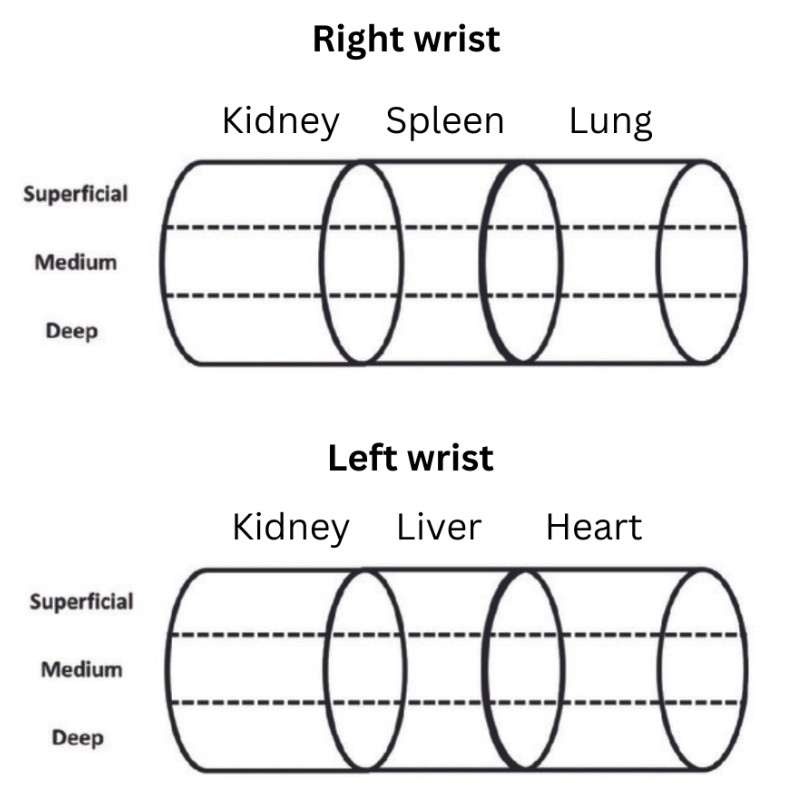Pulse diagnosis is a cornerstone of Traditional Chinese Medicine (TCM) and a common topic of interest for our patients. Many people are curious about what we’re looking for and what the pulse tells us about their condition. I hope that after reading this, you’ll have a better understanding of the pulse next time you see us!
Quick Links to the Sections Below
What is Pulse Diagnosis?
Pulse diagnosis is a system of medical evaluation that involves palpation of different arteries to gain information about a patient. Like TCM, pulse diagnosis has been around for thousands of years and is based on the observations and hypotheses of hundreds of thousands of practitioners. Traditionally, there are 9 places to take the pulse on the body, but today most practitioners focus on the radial artery at the wrist.
Does Pulse Diagnosis Work?
Pulse diagnosis is based on the practitioner’s observation and experience and it does work. However, it is an inherently subjective form of diagnosis so, we use the information gathered from your pulse in combination with our other forms of diagnosis to determine the best plan of care for each patient.
How Does Pulse Diagnosis Work?
Pulse diagnosis is based on the theory that a small part of the body can be used to represent the whole. We take a small section of the radial artery, approximately 3 fingers wide, and divide it into parts to represent different sections of the body.
How We Take the Pulse
The pulse is taken by the acupuncturist with one or both hands by placing three fingers on each wrist of the patient, just below the thumb. The left and right side of the patient’s pulse are each divided into three sections by each of the three fingers. Those sections represent the upper, middle, and lower thirds of the torso or Jiao (Jee-ow).
- The first position corresponds to the Heart and Lungs (Upper Jiao/Torso)
- The second to the Liver and Spleen (Middle Jiao/Torso)
- The third to the Kidneys (Lower Jiao/Torso)
- Each of these three positions can be “read” at the superficial, medium, and deep levels of the radial artery. So with three positions at three depths, that’s nine sections on each wrist!
- Below is a graphic for a visual representation of how the positions and depths would look if you imagine a cross-section of the radial artery.

As acupuncturists, we take the information gathered from the 9 sections, then combine it with the rate, rhythm, shape, and quality at each section to make a complete picture. This takes a tremendous amount of study and time to master and is truly an art form. The final step in the process is to combine the information from the pulse with our other methods of diagnosis to make a treatment plan for each patient.

Does Daily Life Affect Pulse Diagnosis?
Patients often worry when they arrive at their appointment that they’ve just had coffee, walked here fast, sat in traffic, or done something that might affect their pulse when we take it. I always reply that it’s not a problem, because while it does change the pulse, usually only the rate or rhythm has changed and that change is easy to account for.
The rate and rhythm are only a small piece of what we look at, and the quality and shape of the pulse are equally important. Quality is a description of how the vessel feels under your fingers and how it feels when blood moves through it. Common qualities are wiry, which feels like a guitar string, or slippery, which feels like bubbles moving in a water balloon. Shape is the diameter of the vessel. A vessel’s shape can be described by words like thin, full, or hollow.
Hopefully, the next time you make an appointment to see us, you’ll have a bit more knowledge about the pulse and what type of information we look for. Let your acupuncturist know if you have any questions the next time you see us!
You Deserve to Feel Better
As you can see, there are many tools we can use to diagnose and treat a variety of conditions! Your acupuncturist will use puls and tongue diagnosis along with your medical history and current symptoms to create a customized plan for you because you definitely deserve to feel better. To get started, head to our booking page and schedule your first appointment. If you’d like us to check your insurance benefits, we’d be happy to take care of that for you. We are in-network with CareFirst/BlueCross and Aetna.



